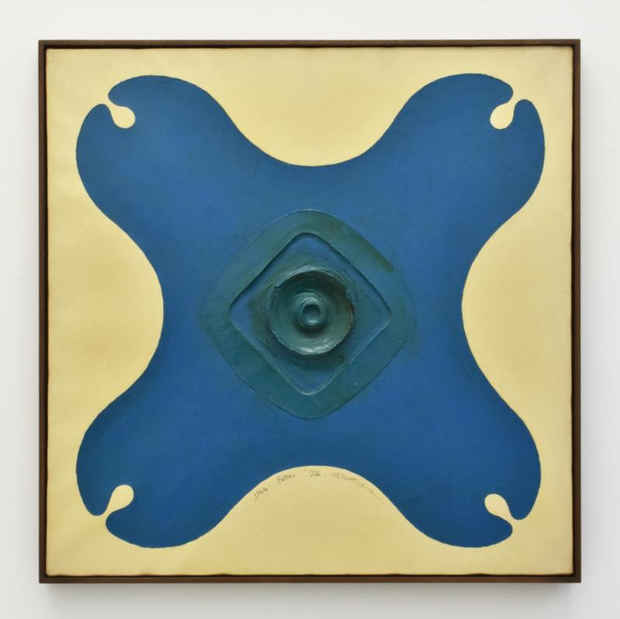Minoru Yoshida “Paintings from 1960s”
ULTERIOR

[Image: Minoru Yoshida "Simple Star (c”) 72" (1964) Oil on canvas, 22 7/8 x 22 7/8 in.]
This event has ended.
The back gallery will feature two 1964 paintings by Minoru Yoshida. Minoru Yoshida (1935–2010) emerged as a brilliant young painter in Kyoto after graduating from Kyoto City University of Fine Arts in the early 1960s. In 1964, introduced by Kazuo Shiraga, he joined the legendary post-war Japanese artists collective Gutai Art Association. A third-generation member of Gutai and the only member from Kyoto, Yoshida was instrumental in Gutai’s development in the ‘60s. During these years, Yoshida began creating abstract paintings which contained forms resembling flowers, microorganisms, and sometimes female genitalia, mostly in a variety of flat blue tones. These abstract works featuring minimal hard-edged shapes and forms were reviewed with great acclaim in Japan.
For Minoru Yoshida’s solo exhibition at Sato Gallery in Tokyo in the spring of 1965, Jiro Yoshihara, the leader of Gutai, wrote the following statement:
“Minoru Yoshida’s paintings are completely his paintings, and they cannot be anything else other than Minoru Yoshida, which is great, and there is nothing to be said. They are oddly strong and I oftentimes feel that I can be easily knocked over by them. However, they also make me feel that I may fall in love completely by some chance. This is the most difficult thing, but Minoru Yoshida will carry it through for sure.”
During the 1960s, Yoshida’s paintings evolved through several different styles. The two paintings on view at Ulterior, both from 1964, are strong examples from this period. Yoshida’s paintings adopt symmetrical abstract images with uniquely built central forms in a white and blue color palette. For some paintings of this era, Yoshida inserted parts made of fiberglass reinforced plastic to create a relief-like raised surface. These devices foreshadow the three-dimensional works that Yoshida began to make starting around 1967. A notable example of his work during this era, Bisexual Flower (1969), was exhibited in 2013 at Gutai: Splendid Playground at the Solomon R. Guggenheim Museum in New York.
Hiroshi Nakamura was born in Shizuoka in 1932 and enrolled in the Nihon University Art Department in 1951, as Japan was still struggling through the aftermath of WWII. In 1953, he collaborated with other artists such as Kikuji Yamashita and Tatuso Ikeda to establish Nihon Seinen Bijutsuka Rengo (Sei-bi-ren), and also began exhibiting at the First Annual Nihon Exhibition and the Seventh Annual Exhibition (1954), both at Tokyo Metropolitan Museum in Tokyo. He has been actively exhibiting since then. Nakamura’s works are in numerous museum collections including: National Museum of Modern Art, Tokyo, Japan; the National Museum of Art, Osaka, Japan; Museum of Contemporary Art, Tokyo, Japan; Nerima Art Museum, Tokyo, Japan; Itabashi Art Museum, Tokyo, Japan; Hamamatsu Municipal Museum of Art, Shizuoka, Japan; Takamatsu Municipal Museum, Kagawa, Japan; and Yokohama Museum of Art, Kanagawa, Japan. Recent museum exhibitions include: Art to be Told: The Eyes of Art Critic Yusuke Nakahara, Kawamura Memorial DIC Museum of Art, Chiba, Japan (2016); Kaiga-sha Hiroshi Nakamura, Hamamatsu Municipal Museum of Art, Shizuoka, Japan (2015, retrospective); Roppongi Crossing 2013: Out of Doubt, Mori Art Museum, Tokyo, Japan (2013); Tokyo 1955–1970: A New Avant-Garde, the Museum of Modern Museum, New York, NY (2012–13); Tablou Machine: Paintings and Models by Hiroshi Nakamura, Nerima Art Museum, Tokyo, Japan (2010, solo); Hiroshi Nakamura: Zuga Jiken 1953–2007, Museum of Contemporary Art, Tokyo, Japan / Nagoya City Art Museum, Aichi, Japan (2007, retrospective). Nakamura lives and works in Tokyo, Japan.
Minoru Yoshida was born in 1935 in Osaka and studied painting at Kyoto City University of Fine Arts, Kyoto, Japan. His works are in the collection of Ashiya City Museum of Art and History, Hyogo, Japan; Ohara Museum of Art, Okayama, Japan; Takamatsu Municipal Museum, Kagawa, Japan; Niigata Prefectural Museum of Modern Art, Niigata, Japan; and National Museum of Modern Art, Kyoto, Japan. His exhibition history and past awards include: Performances in New York, Ulterior Gallery, New York, NY (2018); Gutai: Splended Playground, the Solomon R. Guggenheim Museum, New York, NY (2013); Possible Futures: Japanese Postwar Art and Technology, Inter Communication Center, Tokyo, Japan (2005); Fluorescent Chrysanthemum: Contemporary Japanese Art, ICA London, UK (1968); Gendai no Kuukan ’68: Hikari to Kankyou [Contemporary Space ’68: Lights and Environment], Kobe Sogo Department Store, Hyogo (1968); Nihon Kokusai Bijutsu-ten [Japan International Art Exhibition], Ohara Museum Purchase Prize (1967), Tokyo Metropolitan Art Museum, Tokyo and Kyoto Municipal Museum of Art, Kyoto, Japan ; Mainichi Gendai Bijutsu-ten [Mainichi Contemporary Art Exhibition], Concour Award (1966).
Media
Schedule
from March 08, 2019 to April 06, 2019
Opening Reception on 2019-03-09 from 18:00 to 20:00